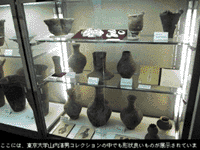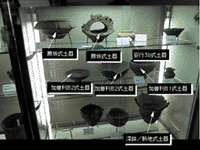
Museum Navigation System
using Augmented Reality Technologies− Noboru Koshizuka −
One of the main objectives of "Museum" is to provide visitors a chance to learn. For this objective, information-providing techniques for visitors are very important. In conventional museums, information or explanation of exhibited materials is presented by using panels or leaflets. However, this method has shortcomings. First, it provides only very small amount of information. The information size is restricted by the physical area of the panel or paper. Second, many people cannot see the same panel at the same time. Next, they sometimes spoil the beauty of exhibitions. In recent years, to provide rich information, computer terminals called as Information KIOSKs are used. However, this cannot solve the latter two problems.
Fig.1 Person wearing an HMD
Thus, we, Tokyo University Digital Museum, have started developing a new information-providing system for exhibited materials by using "augmented reality" technologies in the computer science field. Augmented reality technologies realize some kinds of un-natural and artificial magic in the real world. In other words, augmented reality technologies build unrealistic images in real worlds, while the virtual reality technologies build realistic images in virtual worlds.
Concretely, in our system, a visitor wears a "glass", called as head mounted display (HMD). The visitor can see real images through this "glass", and the "glass" contains an LCD screen in front of the user's eyes, which can display information from a computer over the real images. Wandering around the museum wearing the "glass", the visitor can see explanation and/or information of exhibition in front of his/her eyes. If he/she puts earphones in his/her ears, he/she can listen aural information at the same time. Approaching exhibited materials, the display will switch to more detailed explanation of the materials. We can see this style of displays in amusement SF movies as a view of a robot.
This glass includes a small camera, which measures distance between the visitor and materials, and recognizes what the visitor is looking at. Additionally, the visitor brings an electronic tag, this help to keeping track of the visitors position in the exhibition room. The electronic tags are embedded in many places. The everywhere tags are used for more flexible information providing. This system can provide unrestricted and large amount of information to visitors. In addition, many visitors can see information of the same materials, and large panels or large devices are not required.
Fig.2
Screen shots of Guidance System using
Augmented Reality Technology

